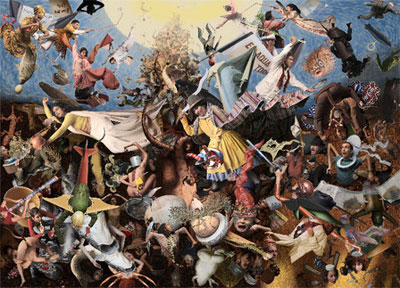 |
| Carole Condé and Karl Beveridge, The Fall of Water 2007. |
What does Working Culture mean? Is it a name for the culture of the workers? Does it mean that the artist “works” culture, the same way artists work clay between their hands? Or is culture itself working – in either sense of the word? The only sure thing is that Working Culture—featuring the art and photographs of Carol Conde and Karl Beveridge—is the newest exhibit at the Dalhousie Art Gallery, and its teaser title is a hint at its enigmatic contents.
Working Culture “features a selection of major photographic projects spanning their (the artists’) 30-year career,” says Jan Allen, curator of the Agnes Etherington Art Centre. But Working Culture chronicles more than Conde and Beveridge’s artistic longevity. It’s more about what lies beneath the surface—what meaning the audience can tease out from brilliantly coloured photographs, lithographs, and inkjet prints littered with a wealth of red herrings and redder cola cans.
|
The exhibit provides its audience with a few hints. A glimpse of the artists’ inner life is offered in Roz Owen and Jim Miller’s award-winning documentary, Community Matters: the Art of Carole Conde and Karl Beveridge. The film revolves around Conde and Beveridge’s “artist’s practice” and is featured as a part of the exhibition. Within Owen and Miller’s short movie, university professors critique the artists as political and artistic leaders; we also get shots of Conde and Beveridge in action—discussing working conditions and pay for artists, for instance.
Some pieces feature feminist undertones. In the cibachrome Standing Up (1981-1982), a factory worker in a plaid shirt—Linda—smokes and fixes her hair during a bathroom break. Throughout the series of photographs, the graffiti on the bathroom wall behind Linda evolves from “TAKE THIS JOB AND SHOVE IT” to “TAKE THIS COMPANY AND UNIONIZE IT… Right On!” According to the accompanying text, this is exactly what Linda is attempting to do; having worked for four years as a full-time warehouse stock-handler, Linda is dealing with professional and personal obstacles as she attempts to unionize.
The Fall of Water (2007) spills over with men bleeding money, leaping fish, and woman warriors. In Cultural Relations: Ad, Art, Plant and Community (2004-2005), dedicated to the memory of Pedro Alderete and featuring a cryptic reference to murdered union leader Isidro Gil, Coke stuff is everywhere (disguised as ambiguous “cola”). No Immediate Threat (1985-1986) turns a bleak eye on the Canadian story of Chalk River with Fight Club-esque graphics. Other pieces deal with depleted fish stocks, privatized health care, women’s wartime labour, and the effects of globalization. That Conde and Beveridge act as activists, as well as artists, becomes clear throughout the exhibit.
|
Carole Conde and Karl Beveridge make “political art”. But, in their case, the pejorative “political” simply isn’t that kiss of death so often lobbed at artwork. The art’s politics are so seamlessly and fearlessly integrated within the framework of the pieces that they become a source of power, rather than a drawback—cataloguing the wrongs done to workers and demanding justice. Implied throughout the exhibit is Conde and Beveridge’s other, vital point: artists, as producers of a final, finished, polished project, are workers, too. They embrace the label. Art Is Political, 1976, features black-and-white photographs of an ecstatic couple dancing—political art made joyful and exuberant.
As I wander through the art gallery, I squint at the dark silhouettes in the darkened projection room, thinking that they must be a part of the exhibit. It takes me a second to realize that the abandoned boxes and stuffed bears are actually bits of the Gallery’s previous exhibit, Exalted Beings, being quietly shuffled away to make room for new art.
It’s business as usual in the gallery. Maybe Conde and Beveridge are right.
